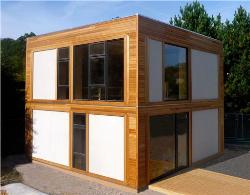May 25 2010
Recent tests on the BaleHaus@Bath, a low carbon house made of straw bale panels at the University of Bath, have confirmed it is more than strong enough to withstand hurricane force winds and turns the children’s fairytale of the three pigs on its head.
 The BaleHaus@Bath
The BaleHaus@Bath
In the children’s story, the pigs hide in a house of straw, only to be blown down by the big bad wolf. However the research at Bath proves that straw is a sturdy sustainable building material after all.
The BaleHaus@Bath was built by industrial partners ModCell as part of a major research project to scientifically assess the performance of straw as a sustainable building material. The two-storey building was officially opened by Grand Designs presenter Kevin McCloud last year.
The research team, led by Professor Pete Walker, Director of the University’s BRE Centre for Innovative Construction Materials, has been monitoring the house since October 2009 for thermal performance and humidity levels and has now tested the structure of the house for resisting winds up to 120mph.
The wind load was simulated using hydraulic jacks which pushed horizontally against the walls with a total force exceeding four tonnes, equivalent to the dynamic force of a hurricane. During the tests, the walls moved no more than four millimetres under peak loads, well within design requirements and as predicted.
The researchers will use this data to develop a theoretical computer model of the house to simulate how a three storey, or even higher, BaleHaus building would withstand such winds.
The research team, including Dan Maskell and Dr Katharine Beadle, had previously conducted similar tests for racking strength on the individual wall panels. This is however the first time a whole house made of straw bale panels has been tested in this way.
Professor Pete Walker said: “Straw is a very environmentally-friendly building material because it is renewable and uses a co-product of farming.
“The crop used to make the straw locks in carbon dioxide as it grows and can be sourced from local farms, saving on transport and minimising the carbon footprint of the building.
"The recent test result is excellent as it has both confirmed the robustness of BaleHaus and validated the computer model, so avoiding the need for further tests and providing basis for safe and efficient structural design.
“We hope the data we’re collecting on the BaleHaus will help strengthen the case for the mainstream building industry switching to using more sustainable building materials like straw.”
The ModCell BaleHaus system consists of prefabricated panels infilled with straw bales and is carbon negative in manufacture. Due to the high insulating properties of the panels, the BaleHaus minimises additional heating requirements and could reduce heating bills in housing by up to 85 per cent, and CO2 emissions by 60 per cent.
Craig White, Director of ModCell, said: “This is a fantastic result. All too often, we are asked whether building with straw is durable.
“Our research at BaleHaus@Bath shows conclusively that building with straw using the ModCell System is not only safe, secure and durable, it is also fit for the 21st century challenge of reducing our CO2 emissions by 80% by 2050.
“If we are completely serious about being ‘carbon free’ we need to rethink the design of our buildings on a large scale. The ModCell BaleHaus system is designed to deliver just such a sustainable method of construction, combining the lowest carbon footprint and the best operational CO2 performance of any system of construction currently available.
“These tests will offer proof that renewable building materials are a realistic option for building on a large scale. It also completely rewrites the story of the three pigs!”
The research work on BaleHaus involves eight industrial partners and has been funded by the Technology Strategy Board and Carbon Connections.